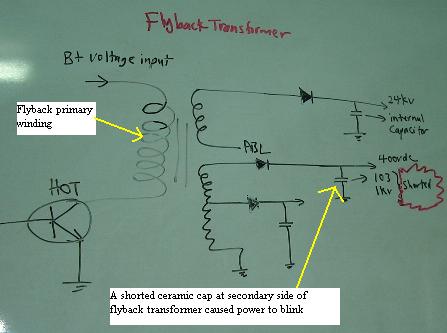How To Repair LG 710E CRT Monitor With Power Blink Problem
LG 710E 17” CRT Monitor came in with the complaint of power blink. A power blink problem can be cause by either in primary or secondary section or even in both sections. A defective power IC, power fet breakdown when under load, high esr in electrolytic capacitor, increased in current sense resistor value, a shorted zener diode, a leaky transistor, open circuit or resistor has changed value in primary side can cause power to blink.
As for the secondary side, a shorted secondary diode, flyback, HOT, horizontal yoke coil, damper diode, B+ fet, an open filter capacitor, shorted IC and etc can cause power to blink as well.
After removing the B+ fet, not only the power didn’t blink, there was display as well and the anode voltage reads about 12 Kilo volt (a good monitor should have about 24 KV). The reason why you got 12 kilo volts is because the boost circuit is not functioning due to the removal of the B+ fet. The display shown a small width and the horizontal size control is already set to the maximum (you can’t get maximum width because the anode voltage is only 12 KV). You can control or set everything in the On Screen Display (OSD) except you can’t bring horizontal size to maximum.
Now where is the culprit hiding? Troubleshooting sometimes can be very frustrated and most of the time is always fun. One of my methods that I liked to use is to touch for any unusually hot components on board with my finger. (Please take note for all electronic repairers-switch off and unplug the power cable and discharge the big filter capacitor in primary side before you begin to touch any components).
Usually after power off, I would touch on the flyback first then to other components surrounding the high voltage section. While browsing the components with my finger I stumbled upon a resin coated ceramic disc capacitor which is quite hot. It is located near the flyback transformer and in fact the capacitor was there is to act as a filter capacitor for the 400 vdc line output as shown from the photo.
The reason why the monitor power blink is because the faulty capacitor become shorted when in full operating voltage (boost circuit is functioning and approximately 60 -70 vdc enter the B+ flyback pin). When the B+ fet was removed (boost circuit not working and only about 40 vdc enter the B+ pin of flyback) the monitor is not working under full operating voltage and the faulty capacitor can still tolerate (partial short) and became hot. I believe if the monitor is switched “on” for a little longer, it would cause the capacitor to develop a direct short circuit and if this happen, removing the B+ fet to test the monitor would not make any different (the power would still blink).
|
|
Copyright@ 2006-2014-www.ElectronicRepairGuide.com All Rights Reserved
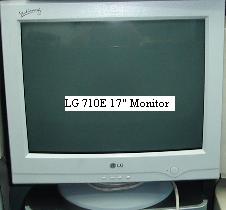
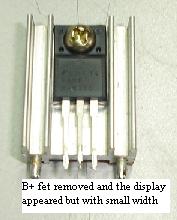 Normally what I do is to remove the B+ fet first and connect a light bulb to distinguish whether is the primary or after the B+
circuit components that caused power to blink. However in this case, I did not put the light bulb and I directly removed the B+ fet and
power on the monitor. For your information, this B+ fet is the N-channel mosfet and this B+ fet is part of the boost circuit.
Normally what I do is to remove the B+ fet first and connect a light bulb to distinguish whether is the primary or after the B+
circuit components that caused power to blink. However in this case, I did not put the light bulb and I directly removed the B+ fet and
power on the monitor. For your information, this B+ fet is the N-channel mosfet and this B+ fet is part of the boost circuit.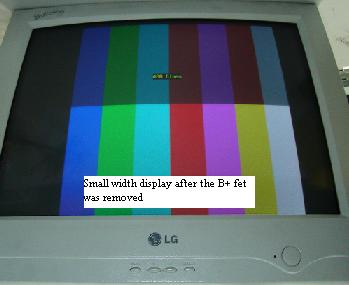 With having a display, it is a good clue to me because I knew that many circuits is working such as power section (so you don’t
suspect primary side anymore), flyback transformer, yoke coils,
With having a display, it is a good clue to me because I knew that many circuits is working such as power section (so you don’t
suspect primary side anymore), flyback transformer, yoke coils,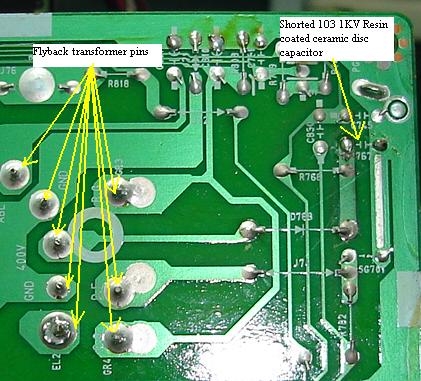
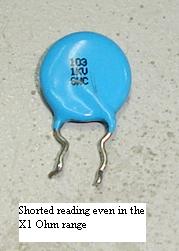 After the cap was removed and checked with an analog meter, it showed a shorted reading even in the X1 ohms range. A good
capacitor should show a charge and discharge activity in the X10 k ohms range. A new capacitor replacement for this LG 710E 17” CRT Monitor
cured the fault.
After the cap was removed and checked with an analog meter, it showed a shorted reading even in the X1 ohms range. A good
capacitor should show a charge and discharge activity in the X10 k ohms range. A new capacitor replacement for this LG 710E 17” CRT Monitor
cured the fault.